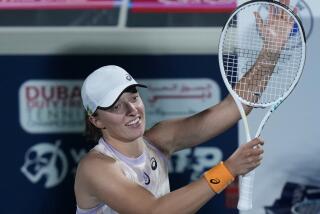Family history says Safina will rise to top
- Share via
For Dinara Safina, it is time. Lil’ sister deserves her own picture over the fireplace.
No more hand-me-downs. No tennis rackets with man-sized grips. No more keys to big-brother’s old convertible.
Safina is now four tennis-match victories away from not having to pass the potatoes first at the dinner table at home. If she gets to the final of the BNP Paribas Open at Indian Wells next weekend, she will become the No. 1 player in the world.
That would make for a pretty special trophy case in the Russian household of Michail and Raouza Safin, one that would contain mementos that no other family could claim. Both son and daughter became No. 1 tennis players in the world.
Never happened before in the sport.
Marat Safin, now No. 27, became tops in the men’s rankings in November 2000. That was only two months after handling no less than Pete Sampras in the U.S. Open final as if Sampras were a club player. Ever since, both Safin and Sampras have said they’d never experienced anything like it. Neither had most in tennis.
Now, with Marat near the twilight at 29, it appears to be Dinara’s time. At 22, she has steadily worked her way into the top echelon. She has made it to two Grand Slam event finals, losing in the 2008 French and in this year’s Australian. And she got a silver medal in the Beijing Olympics.
She is now No. 2 to Serena Williams, who is not playing in the desert. She is seeded first at Indian Wells and battled her way into the third round Friday against a pesky Bulgarian, Tsvetana Pironkova. In a first set that took 1 hour 10 minutes, she kept her cool, fought off three set points in a tiebreaker and prevailed, 7-6 (8), 6-2.
The key phrase there was “kept her cool.”
Like her brother, she has battled on-court demons for much of her career. The family DNA burns with competitive fire. Marat has held the dubious distinction for years on the tour of being most likely to smash a racket. His best year was 1999, when he demolished 48. By 2005, he estimated he had reduced to rubble at least 300.
Former Wimbledon champion and noted head case Goran Ivanisevic, legendary for racket abuse, proclaimed near the end of his career that Marat Safin was a noble successor. And so he has been.
Lil’ sister has been emotionally explosive in her own right. A headline in the Sydney Morning Herald during the month of tennis there captured it well: “Safina Goes From Basket Case to Top of the World.” Another story in the newspaper The Australian described her as: “Mad as a snake. Gloriously so. And on the verge of becoming No. 1.”
That didn’t happen, because Serena Williams dominated in the Australian final, 6-0, 6-3. She also had a chance last fall, when she was one of six players who could become No. 1 at the U.S. Open. She lost in the semifinals to Serena Williams.
Her coach, Zeljko Krajan, is credited with keeping her calm, and during her match with Pironkova, she had numerous opportunities to blow up and never did.
Here, her draw, if form holds, would bring her to a semifinal against No. 4 Vera Zvonereva. And a win there would make her No. 1.
That would also allow her some status of her own on the home front. Though she has said many times that she worships her brother -- “You’re my God” -- and has been quoted as saying he has “the biggest talent of any player and I don’t have half that talent,” she has also hinted recently that it is her time.
“Before, every place I go,” she said, “I am Marat’s sister. Nothing else.” Then later, “I’m not a tourist anymore.”
Four more victories, eight more sets to win. Then big brother can wash the dishes for a change.
--
More to Read
Go beyond the scoreboard
Get the latest on L.A.'s teams in the daily Sports Report newsletter.
You may occasionally receive promotional content from the Los Angeles Times.











